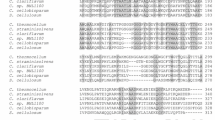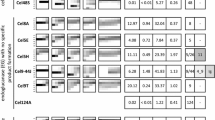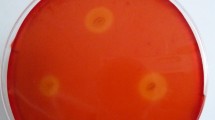Abstract
The cellulosomal family 9 cellulase genes engH, engK, engL, engM, and engY of Clostridium cellulovorans have been cloned and sequenced. We compared the enzyme activity of family 9 cellulosomal cellulases from C. cellulovorans and their derivatives. EngH has the highest activity toward soluble cellulose derivatives such as carboxymethylcellulose (CMC) as well as insoluble cellulose such as acid-swollen cellulose (ASC). EngK has high activity toward insoluble cellulose such as ASC and Avicel. The results of thin-layer chromatography showed that the cleavage products of family 9 cellulases were varied. These results indicated that family 9 endoglucanases possess different modes of attacking substrates and produce varied products. To investigate the functions of the carbohydrate-binding module (CBM) and the catalytic module, truncated derivatives of EngK, EngH, and EngY were constructed and characterized. EngHΔCBM and EngYΔCBM devoid of the CBM lost activity toward all substrates including CMC. EngKΔCBM and EngMΔCBM did not lose activity toward CMC but lost activity toward Avicel. These observations suggest that the CBM is extremely important not only because it mediates the binding of the enzyme to the substrates but also because it participates in the catalytic function of the enzyme or contributes to maintaining the correct tertiary structure of the family 9 catalytic module for expressing enzyme activity.




Similar content being viewed by others
References
Arai T, Ohara H, Karita T, Kimura T, Sakka K, Ohmiya K (2001) Sequence of celQ and properties of CelQ, a component of the Clostridium thermocellum cellulosome. Appl Microbiol Biotechnol 57:660–666
Arai T, Araki R, Tanaka A, Karita S, Kimura T, Sakka K, Ohmiya K (2003) Characterization of a cellulase containing a family 30 carbohydrate-binding module (CBM) derived from Clostridium thermocellum CelJ: importance of the CBM to cellulose hydrolysis. J Bacteriol 185:504–512
Bayer EA, Morag E, Lamed R, Yaron S, Shoham Y (1998) Cellulosome structure; four-pronged attack using biochemistry, molecular biology, crystallography and bioinformatics. In: Claeyssens M, Nerinckx W, Piens K (eds) Carbohydrate from Trichoderma reesei and other microorganisms. Bookcraft, Bath, UK, pp 39–65
Bayer EA, Shimon LJW, Lamed R, Shoham Y (1998) Cellulosomes: structure and ultrastructure. J Struct Biol 124:221–234
Béguin P, Cornet P, Aubert JP (1985) Sequence of a cellulase gene of the thermophilic bacterium Clostridium thermocellum. J Bacteriol 162:102–105
Belaich A, Parsiegla G, Gal L, Villard C, Haser R, Belaich JP (2002) Cel9M, a new family 9 cellulase of Clostridium cellulolyticum cellulosome. J Bacteriol 184:1378–1384
Doi RH, Kosugi A (2004) Cellulosomes: plant-cell-wall-degrading enzyme, complexes. Nat Rev Microbiol 2:541–551
Doi RH, Kosugi A, Murashima K, Tamaru Y, Han SO (2003) Cellulosomes from mesophilic bacteria. J Bacteriol 185:5907–5914
Dygert S, Li LH, Don Florida R, Thoma JA (1965) Determination of reducing sugar with improved precision. Anal Chem 13:367–374
Gal L, Gaudin C, Belaich A, Pages S, Tardif C, Belaich JP (1997) CelG from Clostridium cellulolyticum: a multidomain endoglucanase acting efficiently on crystalline cellulose. J Bacteriol 179:6595–6601
Gasparic J, Churacek J (1978) Laboratory handbook of paper and thin-layer chromatography. Ellis Horwood, Chichester, pp 153–154
Gaudin C, Belaich A, Champ S, Belaich JP (2000) CelE, a multidomain cellulase from Clostridium cellulolyticum: a key enzyme in the cellulosome? J Bacteriol 182:1910–1915
Han SO, Yukawa H, Inui M, Doi RH (2004) Isolation and expression of the xynB gene and its product, XynB, a consistent component of the Clostridium cellulovorans cellulosome. J Bacteriol 186:8347–8355
Henrissat B, Bairoch A (1996) Updating the sequence-based classification of glycosyl hydrolases. Biochem J 316:695–696
Irwin D, Shin DH, Zhang S, Barr BK, Sakon J, Karplus PA, Wilson DB (1998) Roles of the catalytic domain and two cellulose binding domains of Thermomonospora fusca E4 in cellulose hydrolysis. J Bacteriol 180:1709–1714
Kataeva I, Li XL, Chen H, Choi SK, Ljungdahl LG (1999) Cloning and sequence analysis of a new cellulase gene encoding CelK, a major cellulosome component of Clostridium thermocellum: evidence for gene duplication and recombination. J Bacteriol 181:5288–5295
Kosugi A, Murashima K, Tamaru Y, Doi RH (2002) Xylanase and acetyl xylan esterase activities of XynA, a key subunit of the Clostridium cellulovorans cellulosome for xylan degradation. Appl Environ Microbiol 68:6399–6402
Laemmli UK (1970) Cleavage of structural proteins during the assembly of the head of bacteriophage T4. Nature 227:680–685
Ohmiya K, Sakka K, Karita S, Kimura T (1997) Structure of cellulases and their applications. Biotechnol Genet Eng Rev 14:365–414
Shoseyov O, Takagi M, Goldstein M, Doi, RH (1992) Primary sequence analysis of Clostridium cellulovorans cellulose binding protein A (CbpA). Proc Natl Acad Sci U S A 89:3483–3487
Sleat R, Mah RA, Robinson R (1984) Isolation and characterization of an anaerobic, cellulolytic bacterium, Clostridium cellulovorans sp. nov. Appl Environ Microbiol 48:88–93
Tamaru Y, Doi RH (2001) Pectate lyase A, an enzymatic subunit of Clostridium cellulovorans cellulosome. Proc Natl Acad Sci U S A 98:4125–4129
Tamaru Y, Karita S, Ibrahim A, Chan H, Doi RH (2000) A large gene cluster for the Clostridium cellulovorans cellulosome. J Bacteriol 182:5906–5910
Tomme P, Warren RAJ, Gilkes NR (1995) Cellulose hydrolysis by bacteria and fungi. Adv Microb Physiol 37:1–81
Wang WK, Kruus K, Wu JHD (1993) Cloning and the DNA sequence of the gene coding for the Clostridium thermocellum cellulase Ss (CelS), a major cellulosome component. J Bacteriol 175:1293–1302
Zverlov VV, Schantz NN, Schwarz WH (2005) A major new component in the cellulosome of Clostridium thermocellum is a processive endo-beta-1,4-glucanase producing cellotetraose. FEMS Microbiol Lett 15:353–358
Acknowledgements
This research was supported in part by grant DE-DDF03-92ER20069 from the U.S. Department of Energy and a grant from the RITE Institute, Kyoto, Japan.
Author information
Authors and Affiliations
Corresponding author
Rights and permissions
About this article
Cite this article
Arai, T., Kosugi, A., Chan, H. et al. Properties of cellulosomal family 9 cellulases from Clostridium cellulovorans . Appl Microbiol Biotechnol 71, 654–660 (2006). https://doi.org/10.1007/s00253-005-0249-6
Received:
Revised:
Accepted:
Published:
Issue Date:
DOI: https://doi.org/10.1007/s00253-005-0249-6




